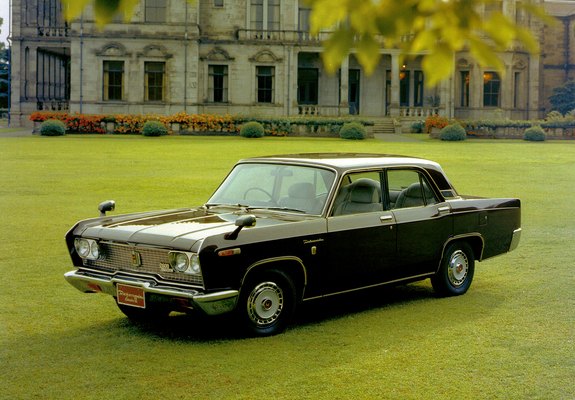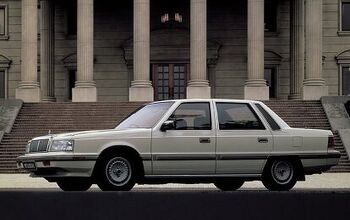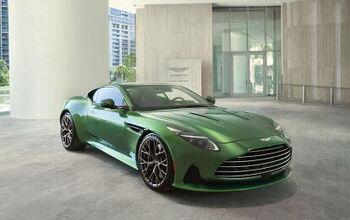Rare Rides: The Sporty and Very Rare 1991 Mitsubishi Debonair, by AMG (Part I)

Today’s Rare Ride is the second attempt Mitsubishi made to build its own full-size executive car for the Japanese Domestic Market. Debonair never moved outside its home market, and always played third fiddle to competition from the likes of Toyota Crown and Nissan Gloria (then a Prince model). Today’s example goes slightly further and adds AMG flavor to the front-drive mix.
There’s a lot of information to cover here, and today we talk about the model’s beginnings.
Mitsubishi introduced the Debonair in 1964 as their first executive flagship sedan. The largest car the company had built prior was the compact class Colt 1000, so Debonair was quite a leap forward. Introduced at the 10th All-Japan Motor Show, it was described as a dignified debut.
Designed by German and former GM designer Hans Bretzner, Debonair was inspired by the 1961 Lincoln Continental. It started out with a 2.0-liter inline-six and progressed eventually to a 2.6-liter inline-four used by some K-car variants. And that engine sharing was a hint at the first Debonair’s longevity: It was popular enough to remain a mainstay in Mitsubishi’s lineup, largely unchanged through 1986. Revised only lightly and just four times throughout its run, by the mid-Eighties Mitsubishi realized modernization was in order.
In 1986, the second Debonair debuted, with a swap to front-drive configuration. In its new format, even the shortest Debonair was longer than the outgoing version. Length determined which of three engines powered the Debonair. The 185-inch model had a 2.0-liter V6, while the 191.5-inch had a 3.0 of six cylinders. The range-topping and longest 197.4-inch version were called Royal 150. It had a supercharged 150 horsepower version of that 2.0-liter V6. The 3.0-liter V6 was Mitsubishi’s 6G72, which you’d know from the Dodge Caravan and Dynasty. The only transmission available was a four-speed automatic. Eventually, the supercharged 2.0 V6 was dropped, as in 1989 a twin-cam 3.0 debuted that upped power from 155 horses to 200.
The change to front-drive and the more pedestrian styling started the decline of the Debonair, and before long Mitsubishi needed to spread the development dollars around a bit. Next time we’ll talk badging and market share.
[Images: Mitsubishi]

Interested in lots of cars and their various historical contexts. Started writing articles for TTAC in late 2016, when my first posts were QOTDs. From there I started a few new series like Rare Rides, Buy/Drive/Burn, Abandoned History, and most recently Rare Rides Icons. Operating from a home base in Cincinnati, Ohio, a relative auto journalist dead zone. Many of my articles are prompted by something I'll see on social media that sparks my interest and causes me to research. Finding articles and information from the early days of the internet and beyond that covers the little details lost to time: trim packages, color and wheel choices, interior fabrics. Beyond those, I'm fascinated by automotive industry experiments, both failures and successes. Lately I've taken an interest in AI, and generating "what if" type images for car models long dead. Reincarnating a modern Toyota Paseo, Lincoln Mark IX, or Isuzu Trooper through a text prompt is fun. Fun to post them on Twitter too, and watch people overreact. To that end, the social media I use most is Twitter, @CoreyLewis86. I also contribute pieces for Forbes Wheels and Forbes Home.
More by Corey Lewis
Latest Car Reviews
Read moreLatest Product Reviews
Read moreRecent Comments
- Teddyc73 Beautiful color, although the overused black wheels detract from it. It's nice to see a car in an interesting color instead of the also grossly overused dull greys.
- Master Baiter If you rear-end someone, it's your fault, period. If motorcycles need more time to stop, then riders need to increase their following distance.
- Master Baiter Until recently, virtually every cell phone and computer was made in China and no one seemed to care. The majority are still built there. I'm not a fan of tariffs as it just gives domestic makers a price umbrella to sell their garbage products to U.S. consumers at higher prices.
- Teleedle It would seem that if the Chinese made cars and trucks are ready to compete on the world market that they should be able to compete without the need for government help through subsidies. That's never going to happen with the mindset of their leadership. The rate at which they've transferred the ability to copy to the rate of their abilities to innovate isn't really astounding, but it is truly indicative of their inherent abilities to see through problems and overcome without a lot of fuss. They just have a different way that seems to continually baffle the Western mind. It only goes back a few thousand years. The rest of the world just has to catch up... Without tariffs, three Seagulls could be bought for the price of one loaded Toyota Corolla. I would settle for a nice small pickup truck that can get 30-35 mpg, if the Chinese want to build something with real durability and value. I'm sure they can do that for about $10-12k US, too, dumping them all the way to the bank. Neither Trump or Biden or Bugbrain want that, though. Restrictive 'targeted' tariff ideas indicate that they all want protectionism and the Chicken Tax to continue. The price of living in freedum in the non compete world... and the hallmark of one upmanship by the political class towards more and more expensive transportation related needs. All costs are ALWAYS passed onto the end consumer. Tariffs are the burden of the extra cost. Tariffs are punitive, remember... as intended. The political class is still living off the backs of their constituents throughout the world... same as it ever was.
- Theflyersfan One day, some of these sellers will come to the realization that cars are not houses and putting expensive upgrades into one doesn't equal a higher selling price down the road. $29,000? The only Challenger that has a chance of value down the road, and only with low miles, is the Hellcat.



































Comments
Join the conversation
I recall becoming aware of the Debonair AMG prior to. I believed it 'd be some tuned up Japanese sports sedan comparable to the Lancer Evo, Lotus Omega or the Mercedes 190E 2.13-16 however it appears like I was wrong. Useful short article. I like it.
Where does the AMG connection start? Or did you mean to say A GM Designer connection? I was imagining that short-lived fling between MB and Mitsubishi in the late 90's, early 00's possibly had an earlier precursor. This is a bit confusing.